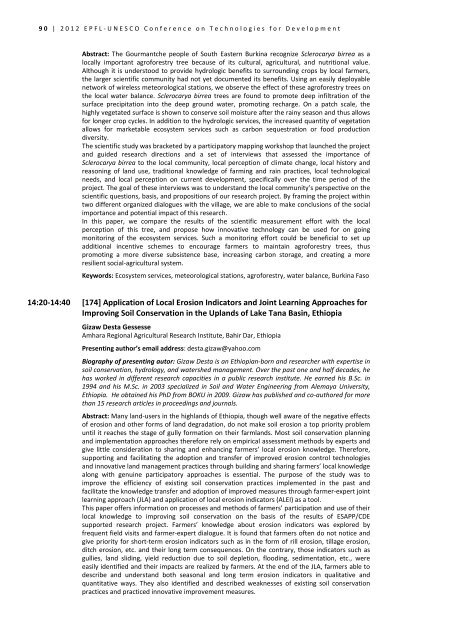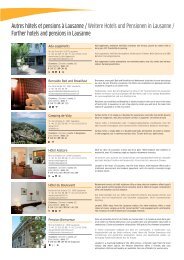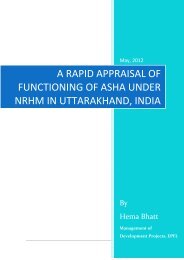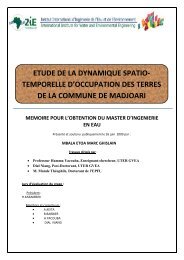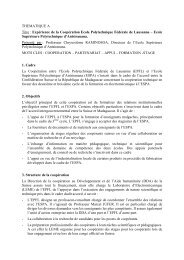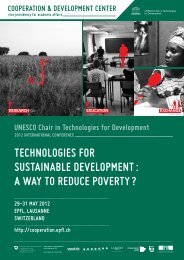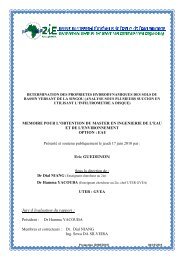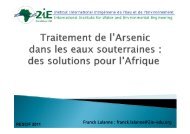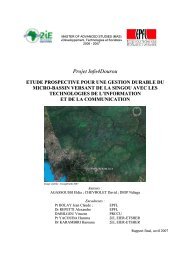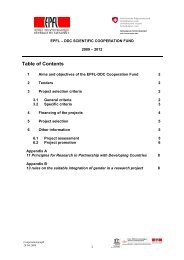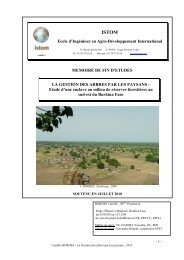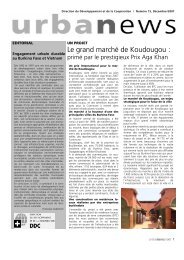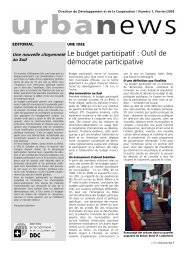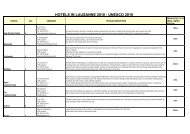TEChNOLOgIES FOR SuSTAINABLE DEVELOPMENT : A WAy TO ...
TEChNOLOgIES FOR SuSTAINABLE DEVELOPMENT : A WAy TO ...
TEChNOLOgIES FOR SuSTAINABLE DEVELOPMENT : A WAy TO ...
Create successful ePaper yourself
Turn your PDF publications into a flip-book with our unique Google optimized e-Paper software.
90 | 2012 EPFL- UNESCO Conference on Technologies for DevelopmentAbstract: The Gourmantche people of South Eastern Burkina recognize Sclerocarya birrea as alocally important agroforestry tree because of its cultural, agricultural, and nutritional value.Although it is understood to provide hydrologic benefits to surrounding crops by local farmers,the larger scientific community had not yet documented its benefits. Using an easily deployablenetwork of wireless meteorological stations, we observe the effect of these agroforestry trees onthe local water balance. Sclerocarya birrea trees are found to promote deep infiltration of thesurface precipitation into the deep ground water, promoting recharge. On a patch scale, thehighly vegetated surface is shown to conserve soil moisture after the rainy season and thus allowsfor longer crop cycles. In addition to the hydrologic services, the increased quantity of vegetationallows for marketable ecosystem services such as carbon sequestration or food productiondiversity.The scientific study was bracketed by a participatory mapping workshop that launched the projectand guided research directions and a set of interviews that assessed the importance ofSclerocarya birrea to the local community, local perception of climate change, local history andreasoning of land use, traditional knowledge of farming and rain practices, local technologicalneeds, and local perception on current development, specifically over the time period of theproject. The goal of these interviews was to understand the local community’s perspective on thescientific questions, basis, and propositions of our research project. By framing the project withintwo different organized dialogues with the village, we are able to make conclusions of the socialimportance and potential impact of this research.In this paper, we compare the results of the scientific measurement effort with the localperception of this tree, and propose how innovative technology can be used for on goingmonitoring of the ecosystem services. Such a monitoring effort could be beneficial to set upadditional incentive schemes to encourage farmers to maintain agroforestry trees, thuspromoting a more diverse subsistence base, increasing carbon storage, and creating a moreresilient social-agricultural system.Keywords: Ecosystem services, meteorological stations, agroforestry, water balance, Burkina Faso14:20-14:40 [174] Application of Local Erosion Indicators and Joint Learning Approaches forImproving Soil Conservation in the Uplands of Lake Tana Basin, EthiopiaGizaw Desta GessesseAmhara Regional Agricultural Research Institute, Bahir Dar, EthiopiaPresenting author’s email address: desta.gizaw@yahoo.comBiography of presenting autor: Gizaw Desta is an Ethiopian-born and researcher with expertise insoil conservation, hydrology, and watershed management. Over the past one and half decades, hehas worked in different research capacities in a public research institute. He earned his B.Sc. in1994 and his M.Sc. in 2003 specialized in Soil and Water Engineering from Alemaya University,Ethiopia. He obtained his PhD from BOKU in 2009. Gizaw has published and co-authored for morethan 15 research articles in proceedings and journals.Abstract: Many land-users in the highlands of Ethiopia, though well aware of the negative effectsof erosion and other forms of land degradation, do not make soil erosion a top priority problemuntil it reaches the stage of gully formation on their farmlands. Most soil conservation planningand implementation approaches therefore rely on empirical assessment methods by experts andgive little consideration to sharing and enhancing farmers’ local erosion knowledge. Therefore,supporting and facilitating the adoption and transfer of improved erosion control technologiesand innovative land management practices through building and sharing farmers’ local knowledgealong with genuine participatory approaches is essential. The purpose of the study was toimprove the efficiency of existing soil conservation practices implemented in the past andfacilitate the knowledge transfer and adoption of improved measures through farmer-expert jointlearning approach (JLA) and application of local erosion indicators (ALEI) as a tool.This paper offers information on processes and methods of farmers’ participation and use of theirlocal knowledge to improving soil conservation on the basis of the results of ESAPP/CDEsupported research project. Farmers’ knowledge about erosion indicators was explored byfrequent field visits and farmer-expert dialogue. It is found that farmers often do not notice andgive priority for short-term erosion indicators such as in the form of rill erosion, tillage erosion,ditch erosion, etc. and their long term consequences. On the contrary, those indicators such asgullies, land sliding, yield reduction due to soil depletion, flooding, sedimentation, etc., wereeasily identified and their impacts are realized by farmers. At the end of the JLA, farmers able todescribe and understand both seasonal and long term erosion indicators in qualitative andquantitative ways. They also identified and described weaknesses of existing soil conservationpractices and practiced innovative improvement measures.


